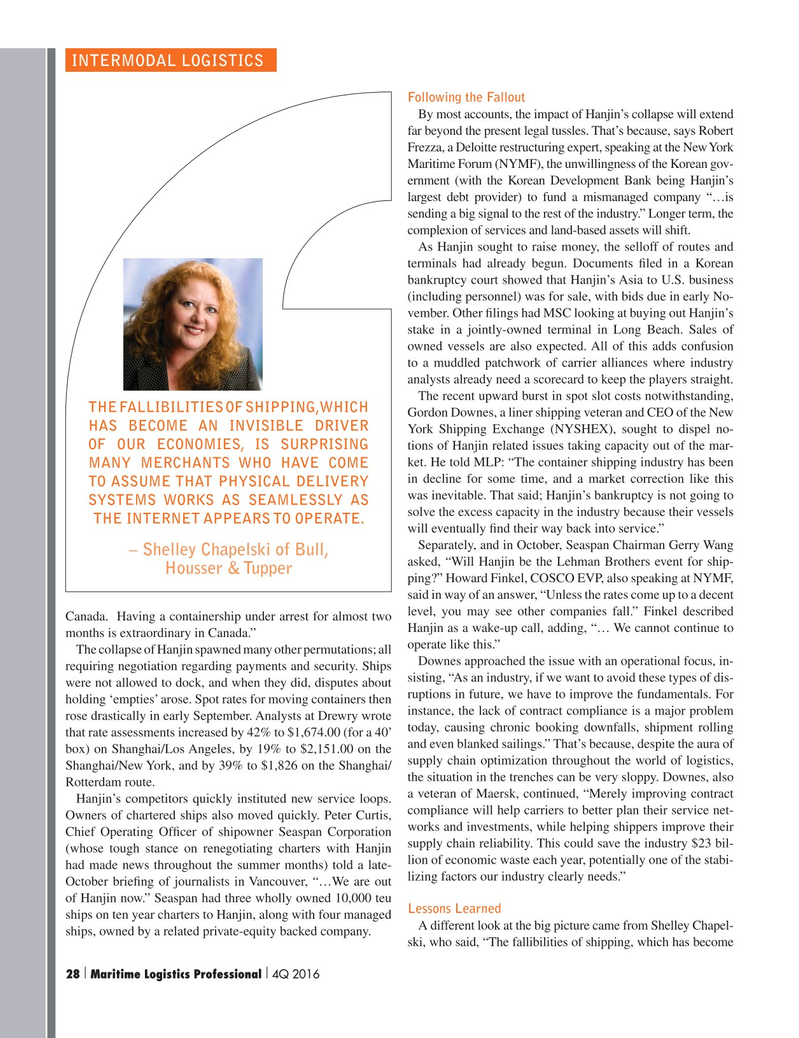
Page 28: of Maritime Logistics Professional Magazine (Q4 2016)
Workboats
Read this page in Pdf, Flash or Html5 edition of Q4 2016 Maritime Logistics Professional Magazine
INTERMODAL LOGISTICS
Following the Fallout
By most accounts, the impact of Hanjin’s collapse will extend far beyond the present legal tussles. That’s because, says Robert
Frezza, a Deloitte restructuring expert, speaking at the New York
Maritime Forum (NYMF), the unwillingness of the Korean gov- ernment (with the Korean Development Bank being Hanjin’s largest debt provider) to fund a mismanaged company “…is sending a big signal to the rest of the industry.” Longer term, the complexion of services and land-based assets will shift.
As Hanjin sought to raise money, the selloff of routes and terminals had already begun. Documents ? led in a Korean bankruptcy court showed that Hanjin’s Asia to U.S. business (including personnel) was for sale, with bids due in early No- vember. Other ? lings had MSC looking at buying out Hanjin’s stake in a jointly-owned terminal in Long Beach. Sales of owned vessels are also expected. All of this adds confusion to a muddled patchwork of carrier alliances where industry analysts already need a scorecard to keep the players straight.
The recent upward burst in spot slot costs notwithstanding,
THE FALLIBILITIES OF SHIPPING, WHICH
Gordon Downes, a liner shipping veteran and CEO of the New
HAS BECOME AN INVISIBLE DRIVER
York Shipping Exchange (NYSHEX), sought to dispel no-
OF OUR ECONOMIES, IS SURPRISING tions of Hanjin related issues taking capacity out of the mar- ket. He told MLP: “The container shipping industry has been
MANY MERCHANTS WHO HAVE COME in decline for some time, and a market correction like this
TO ASSUME THAT PHYSICAL DELIVERY was inevitable. That said; Hanjin’s bankruptcy is not going to
SYSTEMS WORKS AS SEAMLESSLY AS solve the excess capacity in the industry because their vessels
THE INTERNET APPEARS TO OPERATE. will eventually ? nd their way back into service.”
Separately, and in October, Seaspan Chairman Gerry Wang – Shelley Chapelski of Bull, asked, “Will Hanjin be the Lehman Brothers event for ship-
Housser & Tupper ping?” Howard Finkel, COSCO EVP, also speaking at NYMF, said in way of an answer, “Unless the rates come up to a decent
Canada. Having a containership under arrest for almost two level, you may see other companies fall.” Finkel described
Hanjin as a wake-up call, adding, “… We cannot continue to months is extraordinary in Canada.” operate like this.”
The collapse of Hanjin spawned many other permutations; all
Downes approached the issue with an operational focus, in- requiring negotiation regarding payments and security. Ships were not allowed to dock, and when they did, disputes about sisting, “As an industry, if we want to avoid these types of dis- ruptions in future, we have to improve the fundamentals. For holding ‘empties’ arose. Spot rates for moving containers then instance, the lack of contract compliance is a major problem rose drastically in early September. Analysts at Drewry wrote today, causing chronic booking downfalls, shipment rolling that rate assessments increased by 42% to $1,674.00 (for a 40’ box) on Shanghai/Los Angeles, by 19% to $2,151.00 on the and even blanked sailings.” That’s because, despite the aura of supply chain optimization throughout the world of logistics,
Shanghai/New York, and by 39% to $1,826 on the Shanghai/ the situation in the trenches can be very sloppy. Downes, also
Rotterdam route.
Hanjin’s competitors quickly instituted new service loops. a veteran of Maersk, continued, “Merely improving contract
Owners of chartered ships also moved quickly. Peter Curtis, compliance will help carriers to better plan their service net-
Chief Operating Of? cer of shipowner Seaspan Corporation works and investments, while helping shippers improve their (whose tough stance on renegotiating charters with Hanjin supply chain reliability. This could save the industry $23 bil- lion of economic waste each year, potentially one of the stabi- had made news throughout the summer months) told a late-
October brie? ng of journalists in Vancouver, “…We are out lizing factors our industry clearly needs.” of Hanjin now.” Seaspan had three wholly owned 10,000 teu
Lessons Learned ships on ten year charters to Hanjin, along with four managed
A different look at the big picture came from Shelley Chapel- ships, owned by a related private-equity backed company. ski, who said, “The fallibilities of shipping, which has become 28 Maritime Logistics Professional 4Q 2016| | 18-33 Q4 MP2016.indd 28 11/10/2016 10:32:11 AM

 27
27

 29
29
